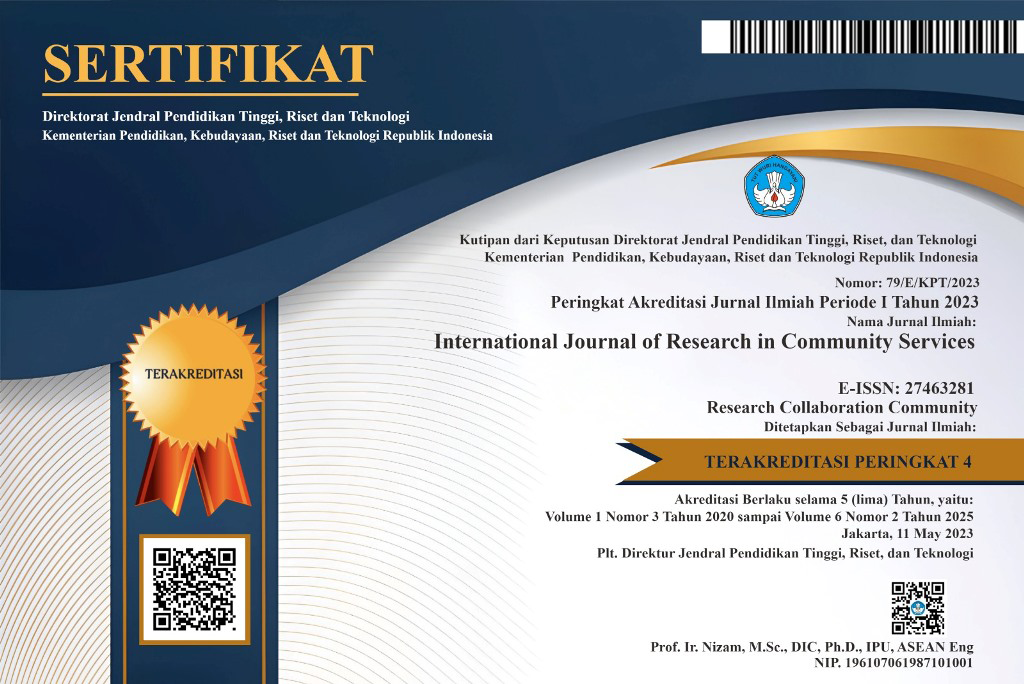Semi-Manual Processing Of Blood Clamps Waste into Chitosan Powder
Abstract
Keywords
Full Text:
PDFReferences
Abdou ES, Nagy KSA, Elsabee MZ, “Extraction and Characterization of Chitin and Chitosan from Local Sources,” Bioresource Technology. 99: 1359-1367, 2008.
Al-Hetar, M.Y., M.A. Zainal Abidin, M. Sariah and M.Y. Wong, “Antifungal activity of chitosan against Fusarium oxysporum f. sp. Cubense,” J. Applied Polym. Sci., 120: 2434-2439, 2011.
Azhar, M., Efendi, J., Sofyeni, E., Lesi, R. F., & Novalina, S, “Pengaruh konsentrasi NaOH dan KOH terhadap derajat deasetilasi kitin dari limbah kulit udang,” Eksakta, 1, 2010.
Bahri, S., Rahim, E. A., & Syarifuddin, S, “Derajat deasetilasi kitosan dari cangkang kerang darah dengan penambahan naoh secara bertahap,” KOVALEN: Jurnal Riset Kimia, 1(1), 2015.
Dewi, S. E., Eddiwan, E., & Efawani, E, “Morphometric and growth patterns of the blood clam (Anadara granosa) from the Bagan Siapi-Api coastal area Rokan Hilir,” Berkala Perikanan Terubuk, 46(3), 37-45, 2018.
Direktorat Jenderal Perikanan Tangkap. 2011. Jakarta.
Djaeni M., Nur R., Hargono, and Aji P, “Prospect of Chitosan from Shrimp Shell as Expoted Commodity,” Community Service Report, Diponegoro University, 2002.
Fernandez-Kim, S.-O., “Physicochemical and Functional Properties of Crawfish Chitosan as Affected by Different Processing Protocols,” A Thesis in Department of Food Science, Seoul National University, Seoul, 2004.
Hanafi M, Amin S., Efrina D., and Suwandi B, “The Use of Shrimp Shell for Chitosan and Glucosamine,” J. Kimia. Terapan. Indonesia. 10, (1-2): 17-21, 2000.
El Knidri, H., Belaabed, R., Addaou, A., Laajeb, A., & Lahsini, A, “Extraction, chemical modification and characterization of chitin and chitosan,” International journal of biological macromolecules, 120, 1181-1189, 2018.
Kumirska, J., Czerwicka, M., Kaczyński, Z., Bychowska, A., Brzozowski, K., Thöming, J., & Stepnowski, P, “Application of spectroscopic methods for structural analysis of chitin and chitosan,” Marine drugs, 8(5), 1567-1636, 2010.
Kusumaningsih, Triana, et al., “Making Chitosan from Snail Shell Chitin,” Biopharmaceutical journal, 2(2):64-68, 2004.
Kurniasih. M., dan D. W. Dwiasi, “Chitin Preparation and Characterization from White Shrimp Skin (Litophenaeus vannamei),” Molecule, 2(2), 2007.
Mardiana, U, “ISOLASI DAN KARAKTERISASI KITOSAN PADA KERANG DARAH (Anadara granosa),” Journal of BTH Medical Laboratory Technology, 1(1), 2021.
Mursida, M., Tasir, T., & Sahriawati, S, “Efektifitas Larutan Alkali pada Proses Deasetilasi dari Berbagai Bahan Baku Kitosan,” Jurnal Pengolahan Hasil Perikanan Indonesia, 21(2), 356- 366, 2018.
No, H.K., Cho, Y.I., Kim, H.R., Meyers, S.P., “Effective Deacetylation of Chitin under Conditions of 15 psi/1210C,” Journal of Agricultural and Food Chemistry, 48(6), pp.2625-2627, 2000.
Oliul Hassan and Taehyun Chang, “Chitosan for Eco-friendly Control of Plant Disease,” Asian Journal of Plant Pathology, 11: 53-70, 2017.
Rhazi M, Desbrieres J, Tolaimate A, Alagui A, Vottero P., “Investigation Different Natural Sources of Chitin: Influence of the Source and Deacetylation Process on the Physicochemical Characteristics of Chitosan,” Polym Int. 49(4): 337-344, 2000.
Rokhati, N., “Pengaruh derajat deasetilasi khitosan dari kulit udang terhadap aplikasinya sebagai pengawet makanan,” Reaktor, 10(2), 54-58., 2006.
Sari, N. I., Edison, E., & Nor, M. L., “Karakteristik Fisik dan Kimia Konsentrat Protein Kerang Darah (Anadara granosa),” Jurnal Teknologi dan Industri Pertanian Indonesia, 11(2), 58-63, 2019.
Setha, B., & Rumata, F., “Characteristics of Chitosan from White Leg Shrimp Shells Extracted Using Different Temperature and Time of the Deasetilation Process,” Jurnal Pengolahan Hasil Perikanan Indonesia, 22(3), 498-507, 2019.
Sinardi., Prayatni Soewondo, Suprihanto Notodarmojo, “Characterization and Application of Chitosan from Green Shells (Mytilus Virdis Linneaus) as a Water Purifying Coagulant,” in The Second International Conference on Sustainable Infrastructure and Built Environment, 2013.
Sinurat, E., & Marliani, R, “Karakteristik na-alginat dari rumput laut cokelat Sargassum crassifolium dengan perbedaan alat penyaring,” Jurnal Pengolahan Hasil Perikanan Indonesia, 20(2), 351-361, 2017.
Suwarda DID, “Studi pembuatan natrium alginat dari Sargassum sp. menggunakan metode ekstraksi modifikasi dengan penambahan natrium karbonat dan karakterisasinya,” skripsi. Lampung (ID): Universitas Lampung, 2016.
Tolaimate A, Desbrieres J, Rhazi M, Alagui A, “Contribution of The Preparation of Chitin and Chitosan with Controlled Physic-Chemical Properties,” Polymer. 44(26): 7939- 7952, 2003.
Windari, N. N. R., Fauziah, S. I., Juniar, A. E., & Purnomo, T., “Biobakterisida Kitosan Cangkang Kerang Darah sebagai Anti Bakteri Ralstonia solanacearum,” In Proceeding Biology Education Conference: Biology, Science, Enviromental, and Learning 16(1) : 280-284, 2019.
Yurimoto, T., “Development of blood cockle aquaculture management techniques in Malaysia,” JIRCAS Newsletter, 69(6), 2013.
Zaeni, A., Fuadah, B., & Sudiana, I. N, “Efek Microwave pada Proses Deasetilasi Kitin dari Limbah Cangkang Udang,” Jurnal Aplikasi Fisika. 13(2) : 48-53, 2017.
DOI: https://doi.org/10.46336/ijrcs.v3i1.185
Refbacks
- There are currently no refbacks.
Copyright (c) 2022 International Journal of Research in Community Services

This work is licensed under a Creative Commons Attribution 4.0 International License.
Published By:
IJRCS: Jalan Riung Ampuh No. 3, Riung Bandung, Kota Bandung 40295, Jawa Barat, Indonesia
Indexed By:

This work is licensed under a Creative Commons Attribution 4.0 International License.
View My Stats








